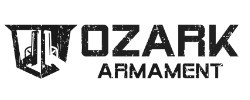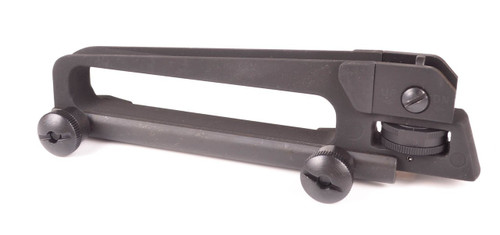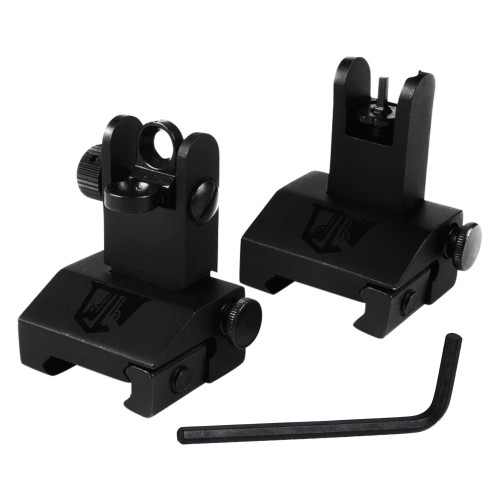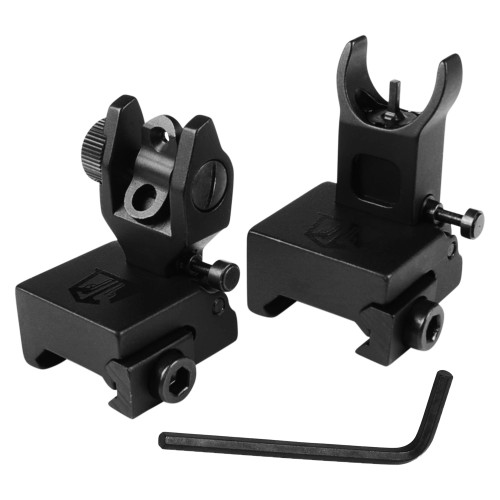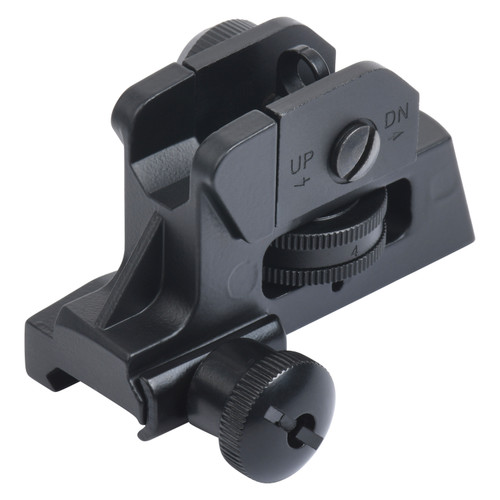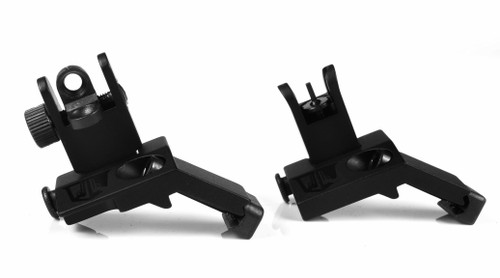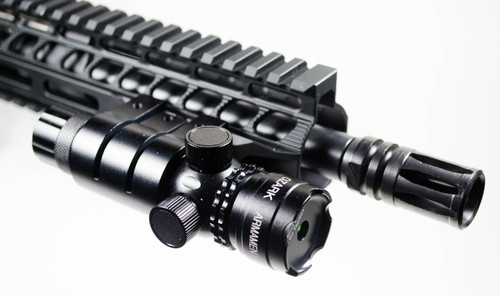Posted by Matt Rice on Feb 14th 2024
Enhancing Shooting Accuracy: A Comprehensive Guide to Iron Sights M4 for Optimal Precision
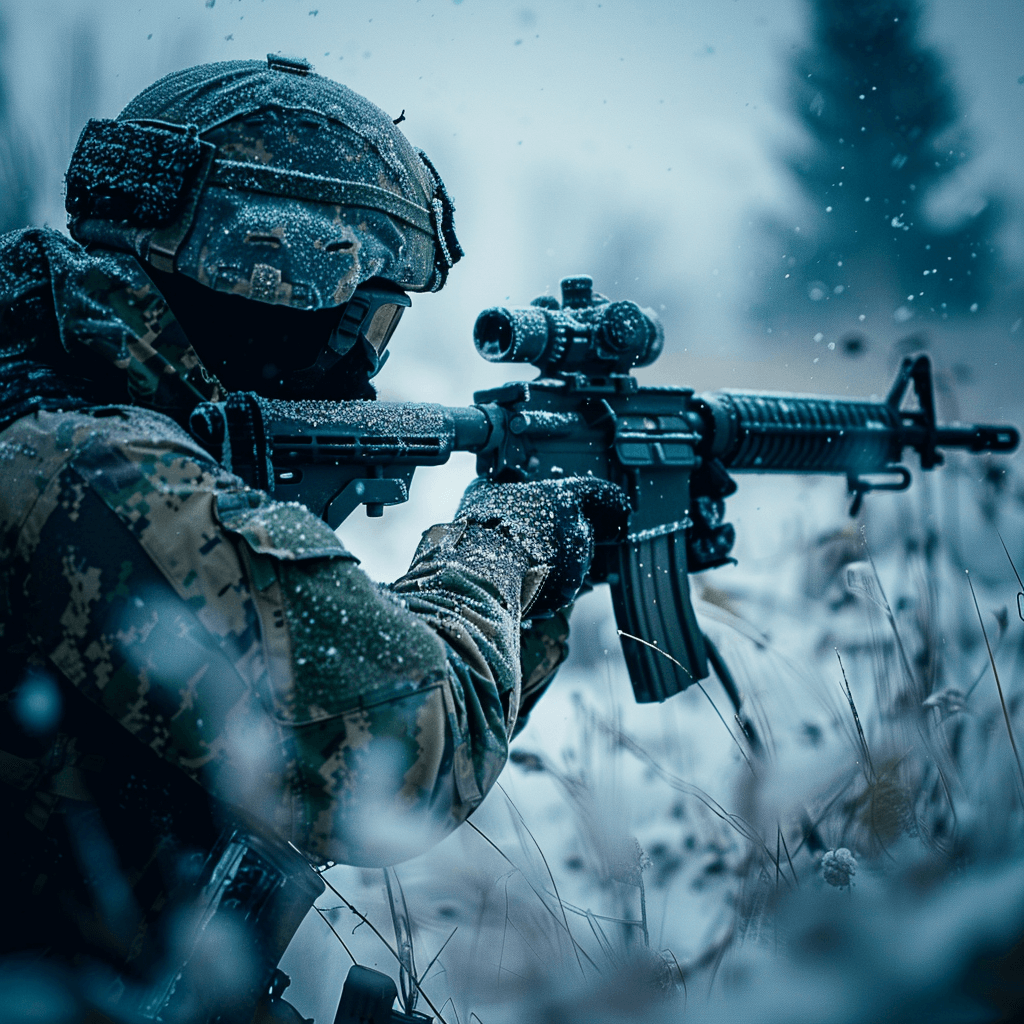
When it comes to enhancing our shooting accuracy, we can't underestimate the power of a good iron sight. Especially when we're talking about the M4, a weapon known for its versatility and reliability. Iron sights, like the ones from Troy Industries, offer a rugged durability that's hard to beat. Made of solid steel, these sights are well-machined, sturdy, and can definitely take a beating.
Not only are they durable, but they're also designed with practicality in mind. Their low-profile design makes them an ideal choice for weapons with a raised top rail system, like the M4. Plus, they're easy to mount and install. So, if you're looking to improve your sight picture or just want a closer view to the barrel, these iron sights might be just what you need. Let's dive deeper into the world of iron sights for the M4.
Overview of Iron Sights
Definition of Iron Sights
Investing in a detail-oriented and reliable iron sight is key. Essentially, iron sights are a system of aligned markers (or 'sights') used to assist in the aiming of a device such as a firearm or crossbow. These are typically composed of two main parts: the front sight located towards the muzzle end and the rear sight stationed towards the shooter. The sight picture that is formed by aligning the front and rear sights correctly helps not only in accurately aiming the weapon, but also in understanding and adjusting to the potential trajectory of the bullet.
Notably, the variations in iron sight designs are vast. Some examples of differing designs from our Ozark Armament collection include the HK Style BUIS, A2 Front Sight, and the Micro Flip Up Backup Sights.
Importance of Iron Sights on an M4
The utility and relevance of a quality iron sight on an M4, M4A1, or M16 can't be overstated. Iron sights are fundamental to shooting accuracy, and their durability and practicality make them an essential piece of kit. They act as a failsafe when optics may fail to work due to battery failure or harsh environmental conditions.
Accurate sights are also instrumental in building fundamental shooting skills. Since iron sights are fixed, they ingrain correct aiming habits and discipline in the shooter. This serves as a solid foundation for enhancing marksmanship skills before transitioning to optics equipped with technological enhancements.
Troy Industries Micro HK Style sight, famously known for its solid steel construction and low-profile design, is a prime example of a quality iron sight designed for M4s with a raised top rail system. Offering a closer sight picture to the barrel, its low-profile design is intrinsically beneficial to the shooter. Proper mounting and installation of these sights can significantly enhance shooting accuracy, providing you with the edge necessary for precise and swift victories.
Through the incorporation of top-notch iron sights, one can significantly optimize and improve their M4's potential, all while ensuring accuracy and precision remain uncompromised.
The next section will explore and analyze various types of iron sights, providing a fitting comparison to the lauded Troy Industries Micro HK Style sight.
Different Types of Iron Sights
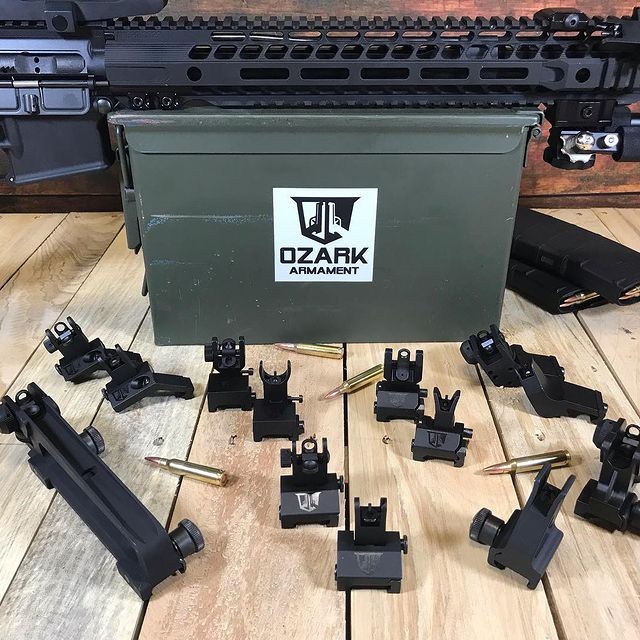
Iron sights are integral components of firearms, including popular weapons such as the M4, M4A1, and M16. They enhance precision, foster proper shooting habits, and serve as a reliable alternative when optics fail. So, let's jump into the different types of iron sights that you could use to optimize your weapon.
Fixed Iron Sights
Fixed iron sights are permanently mounted on the firearm's barrel. Their mainstay has been their ease of use and reliability. In terms of construction, fixed iron sights often feature a simplistic design that eliminates the need for any mechanical manipulation. This can be seen in models like the A2 Front Sight and the Carry Handle Rear Sight. While they are termed 'fixed', some of these models offer windage or elevation adjustments. Their non-moving parts lead to sturdiness and sustained accuracy in comparison to moving sights.
Flip-Up Iron Sights
Flip-Up iron sights, often referred to as Back-Up Iron Sights (BUIS), provide a mixture of adaptability and convenience. These sights can be flipped down when not in use, and then quickly flipped back up when needed. They are a popular choice among shooters who use optical devices, but require a failsafe. Flip-Up sights come in a variety of styles. The HK Style BUIS and Micro Flip Up Backup Sights offer streamlined profiles, while the Fixed Canted Iron Sights offer a versatile off-angle sighting solution.
Adjustable Iron Sights
Adjustable iron sights provide a level of customization that fixed and flip-up sights often lack. Shooters can adjust the windage (horizontal) and the elevation (vertical) to fine-tune their aim. Adjustable Iron Sights can be found in both fixed and flip-up models. A classic example of an adjustable iron sight is the A2 Rear Iron Sight. It's a fixed sight, but shooters can adjust it for both windage and elevation.
The choice between fixed, flip-up, and adjustable iron sights often comes down to personal preference and your shooting requirements. Whether you need the steadfast nature of fixed sights, the convenience of flip-up sights, or the customization possibilities provided by adjustable sights, there is a sighting solution for every shooter.
Pros and Cons of Iron Sights on an M4
Iron sights are integral to accurate shooting with the M4, M4A1, or M16A4. Whether you're using micro iron sights or tall iron sights, understanding their advantages and disadvantages is important. Let's investigate into the pros and cons.
Pros of Iron Sights
Iron sights improve fundamental skills. In the world of M4 carbine shooting, iron sights prove to be a constant tool for improving basic shooting skills. Unlike complex optics, using iron sights directs the shooter to focus on basic shooting principles like sight picture and alignment.
They are reliable. Iron sights, such as those modeled by Ozark Armament, serve as a foolproof failsafe when your primary optic might fail. They're known for their ruggedness and steadfast performance, even in extreme conditions.
Iron sights provide versatility. From fixed sights to those that can flip, such as the HK Style BUIS or Micro Flip Up Backup Sights, there is a range of options available to shooters. Also, designs also vary; for example, the A2 rear iron sight or the A2 front sight, both designed for greater field of view and accuracy.
Cons of Iron Sights
Iron sights can be slower to use. Unlike their optic counterparts, iron sights might not provide the same speed in target acquisition. This is especially crucial in dynamic situations where every second count.
Limited range. When comparing to optics with magnifications, iron sights like the M16 iron sights, invariably have a smaller effective range.
They require more skill to use effectively. Unlike optics that provide a magnified or red-dot point of view, iron sights need shooters to align front and rear sights with the target, which demands more practice and skill.
Remember, choosing between iron sights and optics greatly depends on personal preferences, needs, and the specific situation. Iron sights are more than just an accessory for your M4 or M16, serving as a reliable tool that can enhance shooting accuracy. Whether you're fond of the 45-degree flip-up backup sights, the AR carry handle rear sight, or the fixed canted iron sights, understanding the pros and cons will aid you in making an well-informed choice.
Tips for Using Iron Sights Effectively
Iron sights are the unsung heroes in the firearm world, often overshadowed by tech savvy optical sights, but they hold their own worth when it comes to enhancing shooting accuracy. Whether you're using micro iron sights or tall iron sights, the principles remain the same.
Proper Sight Alignment and Sight Picture
When using the iron sights on an M4, M4A1 or M16, the first step is proper sight alignment. This requires the shooter to align the front sight post centrally within the rear sight aperture, creating a consistent sight picture. The tops of the front and rear sights should be level.
As for the sight picture, it's about correctly positioning the target in relation to the iron sights. In a perfect scenario, the top of the front sight post should bisect the target. It's important to always focus on the front sight, keeping it as clear and crisp as possible in your vision.
Correcting for Windage and Elevation
Understanding adjustments for windage (horizontal axis) and elevation (vertical axis) is vital, especially when it comes to long range shooting. On many iron sights like our own A2 Rear Iron Sight, windage adjustments can be made on the rear sight, while elevation adjustments typically require tweaking the front sight. For windage, remember, the direction you move the rear sight is the direction the bullet impact will move. It's quite the opposite with elevation on the front sight.
Understanding Iron Sight Zeroing
Zeroing your M4 iron sights refers to the process of aligning your sights to intersect the trajectory of the bullet at a certain distance. For our M4 iron sights, the military standard is to zero at 300 meters. But, many prefer a 50/200 meter zero as it offers an effective point aim and point impact from close quarter range up to 200 meters.
Knowing how to effectively use iron sights on an M4, M16 or M4A1 can significantly increase your versatility and adaptability as a shooter. Whether you're using our Battle Sights, HK Style BUIS or Carry Handle Rear Sight, these tips remain applicable. Remember, even the most advanced optic system can fail, but a solid set of steel iron sights will always have your back.
Upgrading Iron Sights on an M4
Ensuring optimal precision and accuracy while shooting is a top priority for any user of the M4, M4A1 or M16 rifles. One of the ways to improve your shooting precision is to upgrade the iron sights on your weapon. Iron sights are a vital part of these rifles and upgrading them can drastically enhance your shooting experience. Now, let's investigate into the details about upgraded front sight posts, upgraded rear sight apertures, and optic compatibility with iron sights.
Upgraded Front Sight Posts
First, let's look at front sight posts. A front sight post on an M4, M4A1 or M16 rifle has a vital role in helping align your target and sight quickly for improved shooting accuracy. With upgraded front sight posts, the sight sits firmly on the rifle and there's little to no wiggling. Contrary to a few misconceptions, these upgraded front sight posts are simple, reliable, and not complicated to use. The micro iron sights are a fine example of an upgrade that can significantly increase these weapon's versatility.
An extra tool might be necessary to adjust front sight posts but, luckily, cheap tools like the Troy Industries Battle Sight Adjustment Tool can do the job.
Upgraded Rear Sight Apertures
Now moving on to rear sight apertures, upgrading these can vastly enhance the functionality of your iron sights. Rear sight apertures, like the DBoys Premium MK16 Full Metal Detachable Adjustable Rear Sight, present shooters with simplicity and adaptability. They provide an effective sight picture and can be adjusted for elevation and windage, improving your overall shooting accuracy. Upgraded rear sight apertures usually don't wiggle after mounting and offer formidable balance.
Optic Compatibility with Iron Sights
Finally, when considering upgrading your iron sights, it's essential to consider their compatibility with other optics for your M4, M4A1 or M16. Iron sights should work perfectly well with your optic systems, providing an absolute co-witness with standard height AR iron sights.
New iron sight designs, such as the UTG Super Slim RMR Mount 2 in 1 Combo Picatinny Black, are CNC Machined from 6061-T6 Aircraft Grade Aluminum and come with weight reducing lightning cuts. This kind of upgraded iron sights not only provide a solid, reliable backup for if your optic systems fail but also offer compatibility with your existing optic systems.
Remember, choosing the right iron sights and upgrading them can significantly increase adaptability, versatility, and precision—making your shooting experience that much better.
Frequently Asked Questions
What are iron sights?
Iron sights are a system of aligned markers that help in aiming a firearm. They provide a reliable, simple, and accurate means of aiming the weapon, especially for M4, M4A1, or M16 rifles. Examples of a quality iron sight are the Troy Industries Micro HK style sights, designed for M4s with a raised top rail system.
Why are iron sights important?
Iron sights serve as a failsafe when optics fail and are crucial in building fundamental shooting skills. Opting for quality and reliable iron sights could not only enhance shooting accuracy but also add to the shooter's adaptability and versatility.
What are the different types of iron sights?
The article discusses three types of iron sights: Fixed, Flip-up, and Adjustable. Fixed iron sights are known for their simplicity and reliability. Flip-up iron sights offer adaptability and convenience, while adjustable iron sights provide extensive customization possibilities.
Why consider upgrading iron sights?
Upgrading iron sights on M4, M4A1, or M16 can improve precision and accuracy. Upgrading the front sight posts can lead to improved alignment and reduced wiggling. Upgrading rear sight apertures can offer an improved sight picture and adjustability for elevation and windage.
What should be considered when upgrading iron sights?
When upgrading iron sights, it's important to consider optic compatibility. The upgraded sights should work well with existing optic systems and should act as a reliable backup in case of optic failure. Correct optic compatibility helps maintain the adaptability, versatility, and precision of the firearm.
ARTICLE WRITTEN BY MATT RICE, OWNER OPERATOR OF OZARK ARMAMENT
